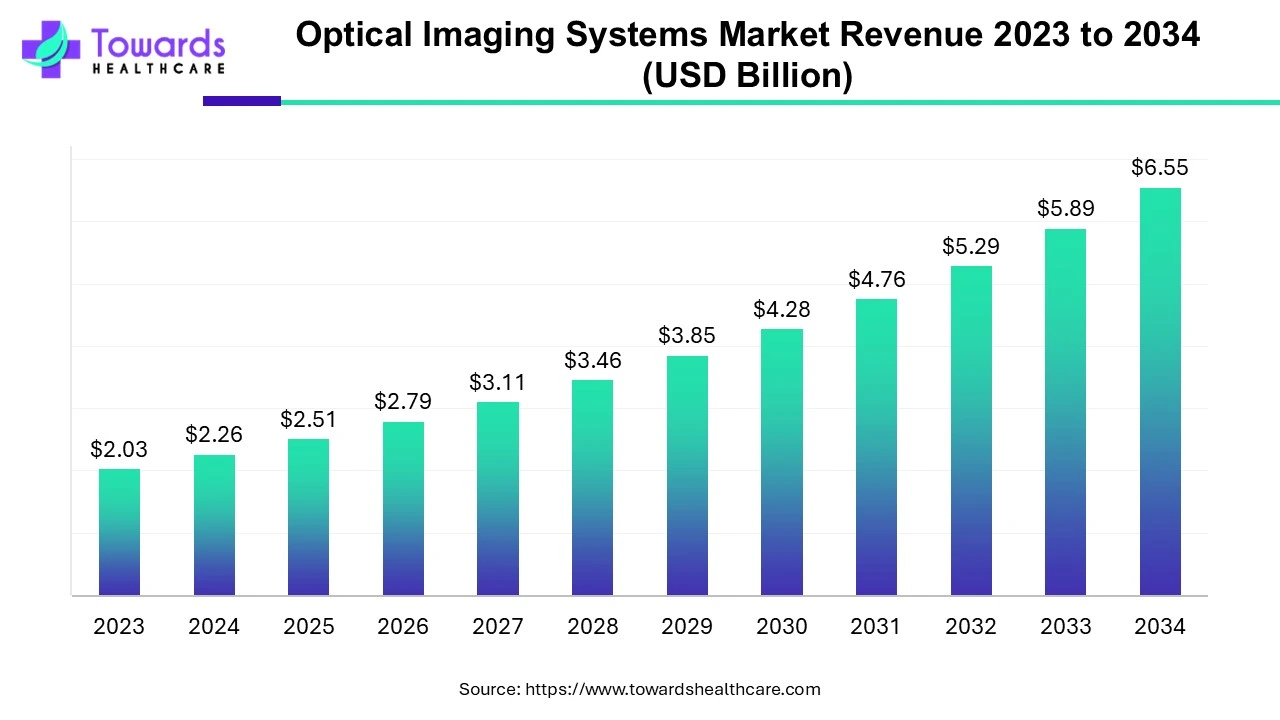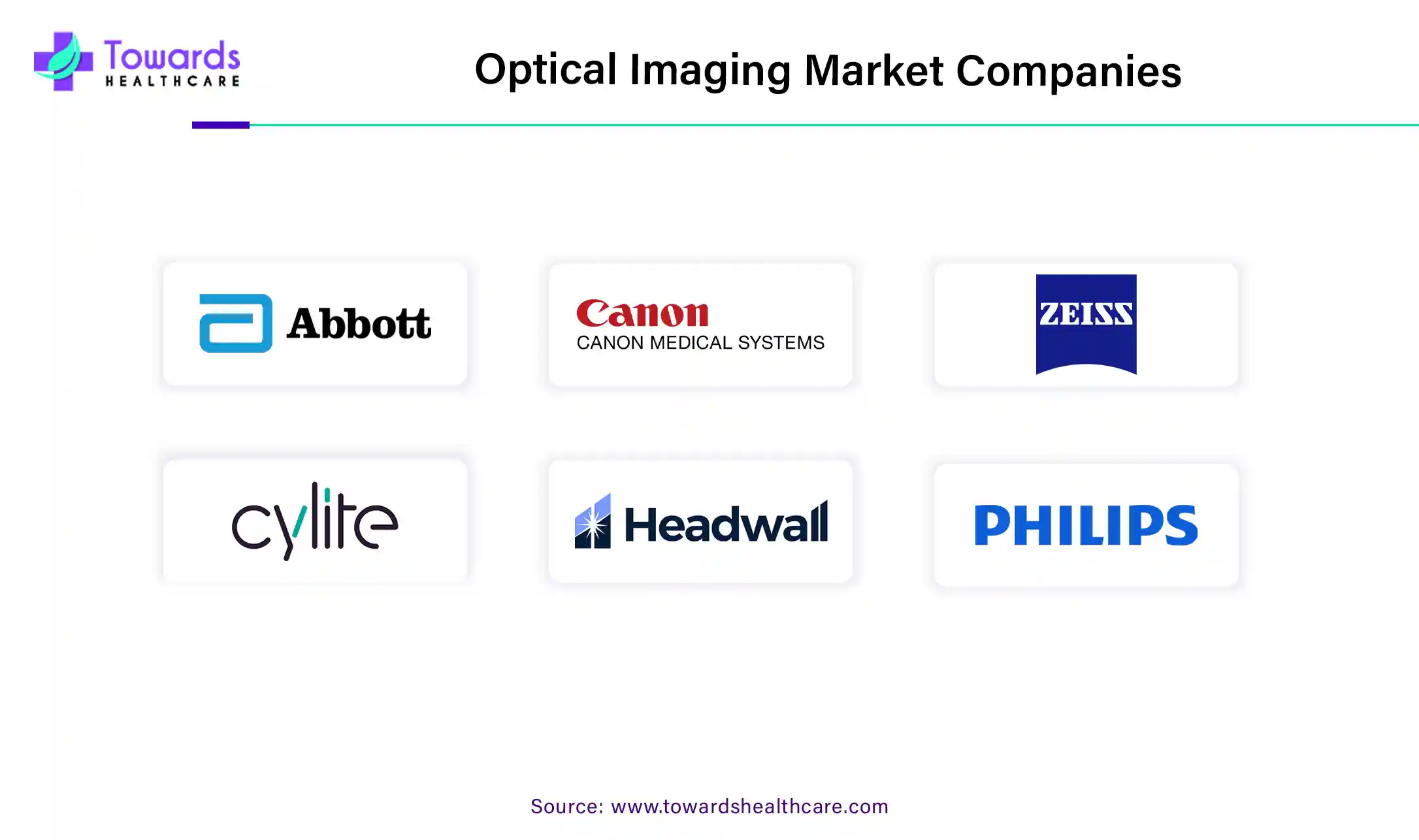April 2025

The optical imaging market was estimated at US$ 2.03 billion in 2023 and is projected to grow to US$ 6.55 billion by 2034, rising at a compound annual growth rate (CAGR) of 11.24% from 2024 to 2034. Technological advancements, the increasing prevalence of chronic disorders, and the growing healthcare infrastructure drive the market.

Optical imaging is a non-invasive imaging technique used to look inside the body. It uses light and special properties of photons to obtain detailed images of organs, tissues, cells, and even molecules. It significantly reduces a patient’s exposure to harmful ionizing radiations like X-rays. Non-ionizing radiation includes visible, ultraviolet, and infrared light. Optical imaging techniques are especially used to visualize soft tissues due to their ability to absorb and scatter light. The different optical imaging techniques include endoscopy, optical coherence tomography (OCT), photoacoustic imaging, Raman spectroscopy, and super-resolution microscopy.
The latest advancements in the medical device sector due to the developments in technology boost the market. The growing demand for patient health and the prevalence of chronic and ocular disorders augment the market.
Optical imaging is a rapidly evolving field due to its increasing importance in current and future interventional medical techniques. Several researchers are investigating innovative imaging techniques using advanced technologies. Apart from visible and ultraviolet lights, the other light imaging techniques studied are fluorescence, near-infrared, bioluminescence, and chemiluminescence. Recent advancements facilitate high-resolution imaging characterized by high brightness, contrast, and sensitivity.
Additionally, the latest technologies like AI and ML assist radiologists in accurately identifying the tumor margin in optical images, aiding in the effective planning of surgeries. Hence, AI can assist in every aspect of imaging and data analysis, such as image generation, image processing, object segmentation, feature extraction, and downstream analysis. This furthermore enhances the performance of optical imaging techniques, thereby enhancing interpretability and lessening dependence on manual annotations. The growing research and development, technological advancements, and the demand for non-invasive techniques for disease identification promote the market.
The major challenge of the market is the limitation of optical imaging instruments to poorly penetrate the tissues. The imaging technique can only penetrate up to 2 cm within the tissues. Another limitation of optical imaging techniques is the high noise/background due to the light absorption and autofluorescence of the tissues. This limits the use of optical imaging techniques over conventional medical imaging techniques.
North America held the largest share of the optical imaging market in 2023. The state-of-the-art research and development facilities, technological advancements, and favorable government policies drive the market. The National Institute of Biomedical Imaging and Bioengineering (NIBIB) supports the development of novel optical imaging technologies through funding. The NIBIB invested a total of $424.6 billion and $440.6 billion in the fiscal year 2022 and 2023, respectively. The Canada Foundation for Innovation by the Government of Canada invests in research facilities in Canada. It announced nearly $86 million to support 316 research projects. Out of these, it invested $150,000 in developing advanced Raman and optical imaging technology projects.
Asia-Pacific is projected to host the fastest-growing optical imaging market in the coming years. The rising prevalence of chronic disorders, increasing investments & collaborations, and technological advancements drive the market. The growing research and development in the Asia-Pacific countries on recent developments in optical imaging technologies augment the market. Several government and private institutions research to advance optical imaging techniques. The market is also driven by favorable government policies and suitable infrastructure to manufacture optical imaging instruments. The National Medical Device Policy of the Indian government provides funding for manufacturing high-end medical devices, including MRI scans and CT scans.
By technology, the optical coherence tomography segment held a dominant presence in the optical imaging market in 2023. Optical coherence tomography (OCT) is a non-invasive technique that takes cross-section pictures of the retina. The rising incidences of ocular disorders and government initiatives to prevent blindness through several screening programs boost the segment’s growth.
By technology, the photoacoustic tomography segment is projected to expand rapidly in the market in the coming years. Photoacoustic tomography is widely used in breast imaging, melanoma detection, endoscopic applications, and brain imaging. It is suitable for continuous and repetitive imaging of disease sites for long-term monitoring of disease progression or therapeutic outcomes.
By product, the imaging systems segment accounted for the largest share of the optical imaging market in 2023. The demand for accurate disease diagnosis using a non-invasive technique potentiates imaging systems. It reduces the exposure of patients to radiation and measures different properties of tissues simultaneously.
By product, the other segment is anticipated to grow with the highest CAGR in the market during the studied years. The growing research and development activities and technological advancements augment the segment’s growth.
By application, the pathological segment led the global optical imaging market and is estimated to grow fastest in the market during the forecast period. Pathology offers a crucial connection between the biological foundation of an image or spectral signature and the clinical results derived from optical imaging. The demand for disease diagnosis, screening, and tissue processing for effective treatment promotes the segment’s growth.
By end-use, the research labs segment registered its dominance over the global optical imaging market in 2023. Research labs implement optical imaging technologies for biomedical applications. Several research labs focus on developing optical imaging technology to improve the quality and enhance the user experience.
By end-use, the pharmaceutical & biotechnological companies segment is predicted to grow with the highest CAGR in the market during the forecast years. The use of optical imaging techniques during several preclinical and clinical trials potentiates the segment’s growth. They also drive drug discovery and development of novel drug candidates using bioluminescent or fluorescent reporters.
By therapeutic area, the oncology segment dominated the optical imaging market globally in 2023 and is estimated to expand rapidly in the market over the coming years. The rising incidences of cancer and the complexity of disease demands using optical imaging. It is comparatively cheap, fast, and sensitive for detecting tumors.

Mr. Koh Yamada, President of Canon Medical Systems India Pvt. Ltd., emphasized the use of the latest technologies to drive innovations in optical imaging. He commented that the company has a comprehensive portfolio of advanced medical imaging, from diagnostic and interventional imaging systems to healthcare IT solutions for the wider healthcare enterprise. The company continuously develops breakthrough technology and applications using AI to support diagnostic imaging and therapeutic needs, all while optimizing patient outcomes.
By Technology
By Product
By Application
By End-Use
By Therapeutic Area
By Region
April 2025
January 2025
December 2024
December 2024